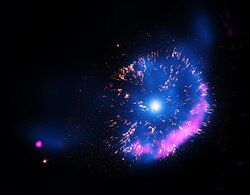GK Persei
| Observation data Epoch J2000.0 Equinox J2000.0 |
|
|---|---|
| Constellation | Perseus |
| Right ascension | 03h 31m 11.82s |
| Declination | +43° 54′ 16.8″ |
| Apparent magnitude (V) | 14.0 |
| Characteristics | |
| Spectral type | Be+K2sdI |
| Astrometry | |
| Radial velocity (Rv) | 28 km/s |
| Proper motion (μ) |
RA: -6.015 mas/yr Dec.: -22.76 mas/yr |
| Parallax (π) | 2.097 ± 0.116mas |
| Distance | 1,560+91 −82 ly (477+28 −25pc) |
| Other designations | |
| Database references | |
| SIMBAD | data |
GK Persei (also Nova Persei 1901) was a bright nova occurring in 1901. It reached a maximum magnitude of 0.2, the brightest nova of modern times until Nova Aquilae 1918. After fading into obscurity at about magnitude 12 to 13 during the early 20th century, GK Persei began displaying infrequent outbursts of 2 to 3 magnitudes (about 7 to 15 times quiescent brightness). Since about 1980, these outbursts have become quite regular, typically lasting about two months and occurring about every three years. Thus, GK Persei seems to have changed from a classical nova like Nova Aquilae 1918 to something resembling a typical dwarf nova-type cataclysmic variable star.
Surrounding GK Persei is the Firework nebula, a nova remnant first detected in 1902 consisting of an expanding cloud of gas and dust bubbles moving up to 1200 km/s.
Nova Persei 1901 was discovered 21 February by Scottish clergyman Thomas David Anderson.
This nova figures in the plot of H. P. Lovecraft's short story "Beyond the Wall of Sleep".
...
Wikipedia

